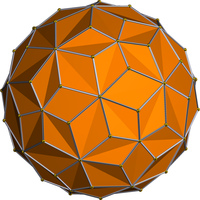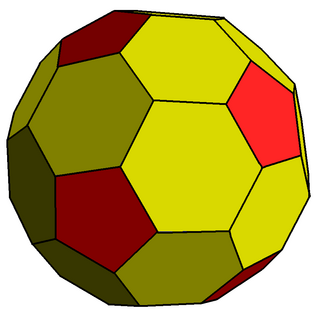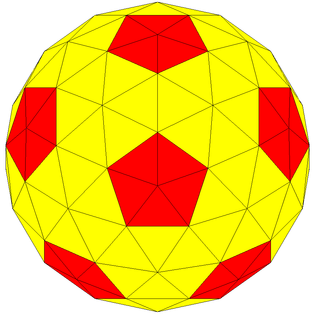 Pentakis dodecahedron |  Deltoidal hexecontahedron |
 Pentagonal hexecontahedron |  Triakis icosahedron |
 Rhombic hexecontahedron |  Small hexagonal hexecontahedron |
In geometry, a hexecontahedron (or hexacontahedron [1] ) is a polyhedron with 60 faces. There are many symmetric forms, and the ones with highest symmetry have icosahedral symmetry:

Geometry is a branch of mathematics concerned with questions of shape, size, relative position of figures, and the properties of space. A mathematician who works in the field of geometry is called a geometer.

In geometry, a polyhedron is a solid in three dimensions with flat polygonal faces, straight edges and sharp corners or vertices. The word polyhedron comes from the Classical Greek πολύεδρον, as poly- + -hedron.

A regular icosahedron has 60 rotational symmetries, and a symmetry order of 120 including transformations that combine a reflection and a rotation. A regular dodecahedron has the same set of symmetries, since it is the dual of the icosahedron.
Four Catalan solids, convex:
- Pentakis dodecahedron - isosceles triangles
- Deltoidal hexecontahedron - kites
- Pentagonal hexecontahedron - pentagons
- Triakis icosahedron - isosceles triangles

In geometry, a pentakis dodecahedron or kisdodecahedron is a dodecahedron with a pentagonal pyramid covering each face; that is, it is the Kleetope of the dodecahedron. This interpretation is expressed in its name. There are in fact several topologically equivalent but geometrically distinct kinds of pentakis dodecahedron, depending on the height of the pentagonal pyramids. These include:

In geometry, a deltoidal hexecontahedron is a Catalan solid which is the dual polyhedron of the rhombicosidodecahedron, an Archimedean solid. It is one of six Catalan solids to not have a Hamiltonian path among its vertices.

In geometry, a pentagonal hexecontahedron is a Catalan solid, dual of the snub dodecahedron. It has two distinct forms, which are mirror images of each other. It has 92 vertices that span 60 pentagonal faces. It is the Catalan solid with the most vertices. Among the Catalan and Archimedean solids, it has the second largest number of vertices, after the truncated icosidodecahedron, which has 120 vertices.
Concave
- Rhombic hexecontahedron - rhombi
27 uniform star-polyhedral duals: (self-intersecting)
- Small dodecicosacron, Great dodecicosacron
- Small rhombidodecacron, Great rhombidodecacron
- Small dodecacronic hexecontahedron, Great dodecacronic hexecontahedron
- Rhombicosacron
- Small icosacronic hexecontahedron, Medial icosacronic hexecontahedron, Great icosacronic hexecontahedron
- Small stellapentakis dodecahedron, Great stellapentakis dodecahedron
- Great pentakis dodecahedron
- Great triakis icosahedron
- Small ditrigonal dodecacronic hexecontahedron, Great ditrigonal dodecacronic hexecontahedron
- Medial deltoidal hexecontahedron, Great deltoidal hexecontahedron
- Medial pentagonal hexecontahedron, Great pentagonal hexecontahedron
- Medial inverted pentagonal hexecontahedron, Great inverted pentagonal hexecontahedron
- Great pentagrammic hexecontahedron
- Small hexagonal hexecontahedron, Medial hexagonal hexecontahedron, Great hexagonal hexecontahedron
- Small hexagrammic hexecontahedron

In geometry, the small dodecicosacron is the dual of the small dodecicosahedron (U50). It is visually identical to the Small ditrigonal dodecacronic hexecontahedron. It has 60 intersecting bow-tie-shaped faces.

In geometry, the great dodecicosacron is the dual of the great dodecicosahedron (U63). It has 60 intersecting bow-tie-shaped faces.

In geometry, the small rhombidodecacron is a nonconvex isohedral polyhedron. It is the dual of the small rhombidodecahedron. It is visually identical to the Small dodecacronic hexecontahedron. It has 60 intersecting antiparallelogram faces.











